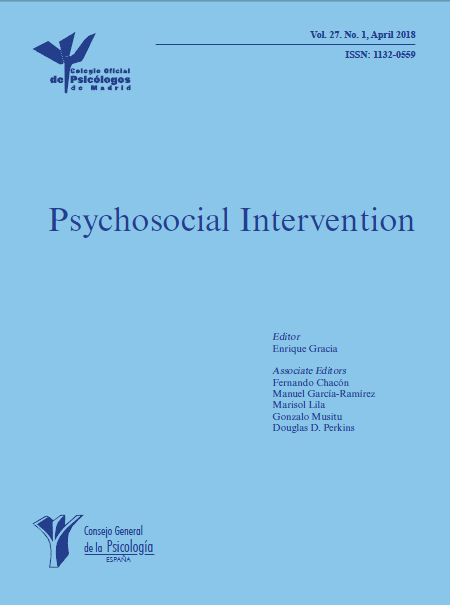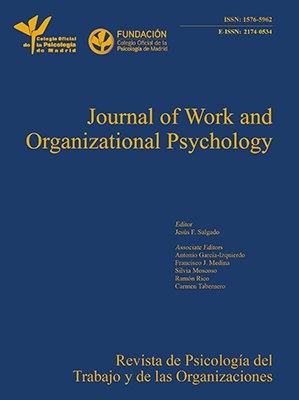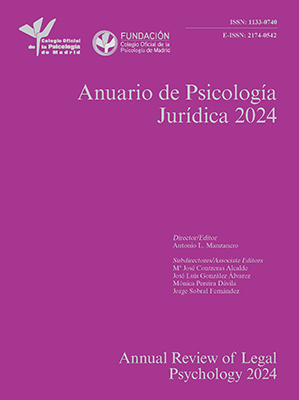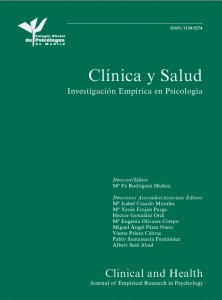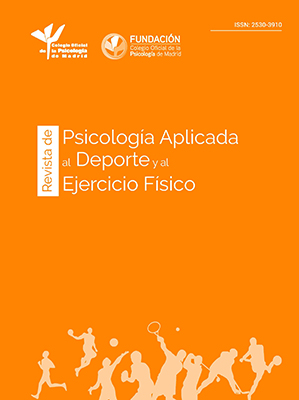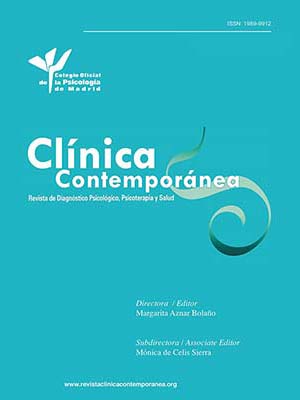
The Polish Version of the Trait Meta-Mood Scale-24 in Adolescents: A Measure of Perceived Emotional Intelligence
[La versiĂłn polaca de la Trait Meta-Mood Scale-24 en los adolescentes: una medida de la inteligencia emocional percibida]
Rosario Cabello1, Izabela Zych2, Vicente J. Llorent2, and Pablo Fernández-Berrocal1
1University of Málaga, Spain; 2University of Córdoba, Spain
https://doi.org/10.5093/psed2025a7
Received 13 March 2024, Accepted 22 October 2024
Abstract
The Trait Meta-Mood Scale is widely used to assess individual differences in perceived emotional intelligence. This instrument measures self-reported emotional attention, clarity, and repair. The present study analyzed the psychometric properties including reliability and validity of a Polish version of the TMMS-24 for adolescents including a broad sample of Polish 16 to 22 years old participants (40.3% girls). Results of a confirmatory factor analysis showed that, as its original version, TMMS-24 has a three-factor structure (attention, clarity, and repair), an adequate internal consistency and correlations among the three factors. In terms of relations with other variables, we found evidence of convergent validity with emotional empathy, and discriminant validity with aggressive behavior. These findings suggest that the Polish version of the TMMS-24 for adolescents is a valid instrument for evaluating perceived emotional intelligence in Polish-speaking adolescents that can be used for basic and applied research, and for the evaluation of programs for the promotion of socioemotional competencies.
Resumen
La Trait Meta-Mood Scale se utiliza ampliamente para evaluar las diferencias individuales en la inteligencia emocional percibida. El instrumento mide la atención emocional, la claridad y la reparación autoinformadas. Este estudio analizó las propiedades psicométricas, entre ellas la fiabilidad y la validez, de una versión polaca de la TMMS-24 para adolescentes, con una muestra amplia de participantes polacos de entre 16 y 22 años (40.3% chicas). Los resultados de un análisis factorial confirmatorio mostraron que, como su versión original, la TMMS-24 tiene una estructura de tres factores (atención, claridad y reparación), una consistencia interna adecuada y correlaciones entre los tres factores. En En cuanto a relaciones con otras variables, se confirma la validez convergente con empatía emocional y validez discriminante con conducta agresiva. Los resultados señalan que la versión polaca del TMMS-24 para adolescentes es un instrumento válido para evaluar la inteligencia emocional percibida en adolescentes polacos, que puede utilizarse para la investigación básica y aplicada, y para la evaluación de programas de refuerzo de las competencias socioemocionales.
Palabras clave
Inteligencia emocional, TMMS-24, Adolescentes, Versión polaca, Propiedades psicométricasKeywords
Emotional intelligence, TMMS-24, Adolescents, Polish version, Psychometric propertiesCite this article as: Cabello, R., Zych, I., Llorent, V. J., & Fernández-Berrocal, P. (2025). The Polish Version of the Trait Meta-Mood Scale-24 in Adolescents: A Measure of Perceived Emotional Intelligence. PsicologĂa Educativa, 31(1), 55 - 61. https://doi.org/10.5093/psed2025a7
Correspondence: rcabello@uma.es (R. Cabello).Adolescence is a period of high risk for the emergence of mental health problems such as drug use, addiction, anxiety and depressive disorders. Between 3% and 4% of adolescents suffer from behavioral disorders including conduct disorders, oppositional defiant disorder, or attention-deficit hyperactivity disorder (ADHD; Costello et al., 2011; Olson et al., 2021; Schlesinger et al., 2023). Research has shown that one of the protective factors against adolescent maladjustment is a high level of emotional intelligence (Tejada-Gallardo et al., 2020; Vega et al., 2021). Nevertheless, there are still many gaps in knowledge regarding emotional intelligence. Among them, it is still necessary to advance knowledge on emotional intelligence in different geographic areas and cultures. This is only possible if reliable and validated instruments to measure emotional intelligence are available. These instruments still need to be validated in Poland. Emotional intelligence is defined as “the ability to perceive accurately, appraise, and express emotion, the ability to access and/or generate feelings when they facilitate thought, the ability to understand emotion and emotional knowledge, and the ability to regulate emotions to promote emotional and intellectual growth” (Mayer & Salovey, 1997, p. 10). Since Salovey and Mayer (1990) first described the concept of emotional intelligence, various theoretical models and instruments have been developed for its measurement. In an attempt to organize the emotional intelligence literature, Joseph and Newman (2010) proposed three models according to the type of instruments used for its measurement. According to the Self-report ability model, emotional intelligence is a combination of emotional aptitudes measured through self-reports where participants estimate their level of emotional intelligence according to their subjective perception (Fernández-Berrocal & Extremera, 2008). There are no correct and incorrect answers to items used within the self-report ability model, and the Trait Meta-Mood Scale (TMMS; Salovey et al., 1995) is the most widely used instrument within this approach. The Performance-based ability model conceptualizes emotional intelligence as a form of intelligence that involves reasoning about emotions (Mayer et al., 2016) where it is measured by solving emotional problems through performance tests with correct and incorrect answers. The Mayer-Salovey-Caruso Emotional Intelligence Test (MSCEIT; Mayer et al., 2002) is the most representative instrument used within this model. Finally, according to the Self-report mixed model, emotional intelligence is a broad concept that includes motivations, interpersonal and intrapersonal abilities, empathy, personality factors and well-being, among others (Mayer et al., 2008), and employs self-report instruments that measure a subjective perception of emotional intelligence according to the participants. The Bar-On Emotional Quotient Inventory (EQi) is a commonly employed test for this model (Bar-On, 2004). The Trait Meta-Mood Scale (TMMS) was developed by Salovey et al. (1995) and has been widely used as a measure of individual differences in perceived emotional intelligence. Participants estimate their own perceived Attention to emotions, perceived emotional Clarity, and perceived emotional Repair. Perceived emotional intelligence has predominantly been studied in adults, and people with high perceived emotional intelligence have been found to be less likely to suffer from depression (Ciarrochi et al., 2002; Saklofske et al., 2003) and alcohol abuse (Austin et al., 2005) and are more likely to show good general and psychological health (Tsaousis & Nikolaou, 2005). Although the number of studies with adolescents is still low, perceived emotional intelligence has been found to be an important protective factor against different problems. Regarding different models, it was found that low levels of self-reported emotional intelligence had stronger associations with psychological maladjustment than low levels of emotional intelligence assessed by performance tests (Resurrección et al., 2014). For example, low Emotional Clarity and Emotional Repair are related to high scores in depression and anxiety (Fernández-Berrocal et al., 2006; Fernández-Berrocal et al., 1999; Latorre & Montañés, 2004; Liau et al., 2003; Williams et al., 2004). A longitudinal study of community adolescents (Salguero et al., 2012) demonstrated that high scores in emotional Attention and low scores in Emotional Clarity and Emotional Repair were associated with poorer psychological adjustment, such as higher anxiety, depression, social stress, and low levels of general mental health one year later. Other cross-sectional studies have found a relationship among perceived emotional intelligence, empathy, and aggression. For example, young adults and adolescents with high empathy showed high levels of perceived emotional intelligence (Garaigordobil, 2020; Gómez-Leal et al., 2021; King et al., 2012). A meta-analysis including several primary studies that measured perceived emotional intelligence with TMMS-24 showed that low perceived emotional intelligence was related to high aggression in adolescents (Vega et al., 2021). The TMMS has been translated to different languages (Fernandez-Berrocal et al., 2004; Maria et al., 2016; Queirós et al., 2005) and adapted to different populations. TMMS is therefore one of the most commonly used measures of perceived emotional intelligence around the world, with validation studies in Australia (Palmer et al., 2003), Portugal (Brito-Costa et al., 2016), China (Li et al., 2002), and Spain (Fernandez-Berrocal et al., 2004), among others, and it has excellent psychometric properties (Salovey et al., 1995). Besides the long version of the TMMS, a short version (TMMS-24) was developed in Spain, showing a high reliability for each component with Spanish adults (TMMS-24; Fernandez-Berrocal et al., 2004). Psychometric properties of the TMMS-24 were also tested with a Spanish adolescent population including students aged between 12 and 17 years and its reliability and validity were adequate (Salguero et al., 2010). Similar findings were described in two studies with samples of 3,255 Chilean adolescents (Gómez-Núñez et al., 2018) and 4,681 Brazilian adolescents (Câmara et al., 2023), showing satisfactory psychometric properties of the TMMS–24 for this age, corroborating its multidimensional structure and their relationship with variables such as life satisfaction and psychological well-being. Adolescent populations around the world experience biological transition from puberty to adolescence, with important challenges and opportunities regarding their social, emotional, and sexual development (Hayward, 2003). According to the World Health Organization (WHO), 20% of adolescents suffer mental health problems, mainly related to anxiety, depression, and interpersonal violence. Similarly to other countries, a study with Polish adolescents showed that a quarter of the adolescent participants experienced anxiety and depression disorders and aggressive behavior (Dziedzic et al., 2021). Other problem behaviors such as bullying are present around the world including Poland (Jaskulska et al., 2022; Pyzalski et al., 2022). Evaluations of school intervention programs implemented in thousands of schools worldwide (Weissberg et al., 2015) showed that increasing emotional intelligence in adolescents is related to an increase in levels of empathy, prosocial behavior, psychological adjustment and a decrease in aggressive behaviors (Castillo-Gualda et al., 2018; Durlak et al., 2011; Taylor et al., 2017). Indeed, several longitudinal studies in diverse countries suggest that the relationship between emotional intelligence and psychological maladjustment has transcultural validity (Resurrección et al., 2014). Although there are several instruments to measure emotional intelligence in Poland, it is still necessary to describe psychometric properties of the TMMS in Polish adolescents. Some validation studies of Polish questionnaires inspired on the TMMS have been conducted with adults (Borkowska et al., 2006; Szczygiel et al., 2015), but it is still necessary to obtain a Polish version of the TMMS with adolescents. An assessment of emotional intelligence is crucial for cross-national and comparative research and for evidence-based practice, where intervention programs need to be assessed. The main goal of the present study was to analyze psychometric properties of a Polish version of the TMMS-24 in a large sample of Polish adolescents. Specifically, the study aimed at i) evaluating reliability and internal consistency of the Polish version of the TMMS-24; ii) analyzing the construct validity via confirmatory factor analysis (CFA) and the analysis of the correlations of the three TMMS-24 subscales; iii) analyzing gender and age differences in perceived emotional intelligence measured through the TMMS-24; and iv) evaluating discriminant and convergent validity through correlations between the TMMS-24 scores with aggression and empathy. Participants This study was conducted with 904 Polish late adolescents enrolled in six upper secondary schools in three different locations in Lesser Poland (Malopolska) voivodeship in Poland. Schools were selected through convenience sampling in rural and urban locations. Among the participants, 40.3% were girls and 59.7% were boys. The age of the participants ranged from 16 to 22 years (age M = 17.62, SD = 1.10). These students were attending different types of upper secondary education schools (i.e., Technical Secondary Schools, Lyceums, and Vocational Learning). Thirty-nine questionnaires contained more than 50% of missing data or a clear response bias (e.g., zigzagging), and therefore were eliminated. Instruments Trait Meta Mood Scale–24 (TMMS-24; Fernandez-Berrocal et al., 2004) The TMMS-24 is a well-known validated Spanish short version of the original TMMS designed by Salovey et al. (1995) to assess perceived emotional intelligence. This short Spanish version contains 24 items answered on a 5-point Likert scale from 1 (strongly disagree) to 5 (strongly agree) and assesses the extent to which people attend to and value their feelings (Attention), feel clear rather than confused about their feelings (Clarity), and use positive thinking to repair negative moods (Repair). This version had excellent Cronbach’s alphas in its original validation study (.90, .90, and .86, respectively). The TMMS-24 was translated into Polish by one of the authors of this study who is a Polish native speaker (IZ) and then back-translated into Spanish by two independent translators. The Polish version was reviewed by a group of experts (researchers in the field and directors of the enrolled schools) who were native Polish speakers. Emotional Empathy Scale (Caruso & Mayer, 1998) This scale contains 30 items measuring affective empathy answered on a 5-point Likert scale ranging from 1 (totally disagree) to 5 (totally agree), with an excellent Cronbach’s alpha of .86. The original version contained 6 factors, i.e., Suffering (11 items), Positive Sharing (5 items), Responsive Crying (3 items), Emotional Attention (4 items), Feel for Others (4 items), and Emotional Contagion (3 items). This scale was translated into Polish and back-translated into English. A confirmatory factor analysis confirmed the original factor structure in the Polish version (robust method with polychoric correlations, SB chi-square = 1134, df = 351, p < .01, NFI = .93, CFI = .95, RMSEA = .062, 90% CI [.058, .066], loadings with p < .05). This version had an excellent standardized Cronbach’s alpha of .92. Peer-Aggression (Del Rey et al., 2017) Peer aggression was measured with 4 items about different aggressive behaviors perpetrated towards peers such as hitting, isolating, or rejecting, threatening, and insulting a classmate answered on a 5-point Likert scale ranging from 1 (never) to 5 (always). A confirmatory factor analysis showed that these four questions were grouped in one factor (robust method with polychoric correlations SB chi-square = 7.57 df = 2, p = .02, NFI = .99, CFI = .99, RMSEA = .058, 90% CI [.019, .10], loadings with p < .05) and very good standardized Cronbach’s alpha (α = .85). Procedure Head-teachers of each school selected by convenience were contacted and informed about the objectives of this study. Students consented to participate in the study and filled in the questionnaires during their regular classroom hours supervised by senior researchers. They were informed that there were no correct and incorrect answers, they were asked to respond sincerely to each question and anonymity was assured. Participation was voluntary and participants had the right to withdraw from the study at any moment. Data were used only for research purpose and only the research team had access to the individual data. The study followed all the national and international ethical standards. Table 1 Standardized Cronbach’s Alphas and McDonald’s Omegas of the Scales Used in the Current Study   The Research Ethics Committee of the University of Málaga approved the study protocol (14-2019-H) as part of the project UMA18- FEDERJA-114. Participants gave informed consent and were assessed in accordance with the Helsinki declaration. Data Analysis Reliability statistics such as McDonald’s omegas and standardized Cronbach’s alphas were calculated with FACTOR 10 (Lorenzo-Seva & Ferrando, 2015). Descriptive statistics such as means, standard deviations, skewness, kurtosis per item and total score, and Pearson correlations (to test concurrent validity through correlations among total scores) were calculated with PASW-Statistics 18. A confirmatory factor analysis was conducted with EQS 6.2 software with maximum likelihood robust method and polychoric correlations. This method is recommended for ordinal data (i.e., items). Goodness of fit was tested according to different indices such as CFI value above .90, RMSEA below .08 and NFI above .90 (Bentler, 1990). Table 2 Descriptive Statistics of Each Item of the Polish Version of Trait Meta Mood Scale 24 Questionnaire  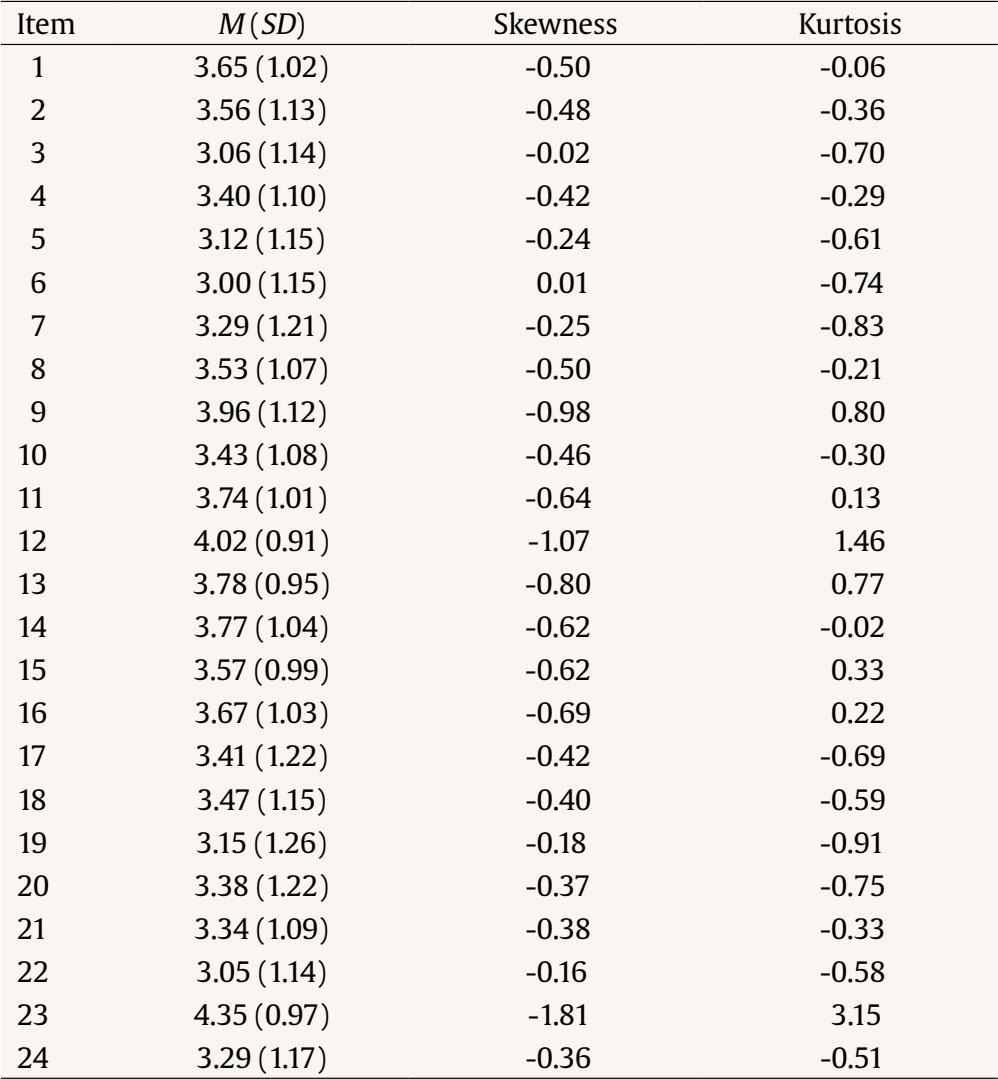 All the scales used in this study had a high degree of reliability with very good Cronbach’s alphas and McDonald’s omegas (see Table 1). Considering both, alphas and omegas, Polish version of TMMS-24 showed very good internal consistency in all the subscales (i.e., Attention, Clarity, and Repair). Figure 1 A Confirmatory Factor Analysis of the Polish Version of Trait Meta Mood Scale – 24.  Note. SB chi-square = 904.60, df = 249, p < .01, CFI = .94, NFI = .92, RMSEA = .06 (95%CI[.055, .064]. All factor loadings are significant (p < .01). Table 3 Percentiles of the Mean Scores in Emotional Attention, Clarity and Repair in Boys and Girls and Percentage of Participants with Floor and Ceiling Scores in Each Subscale   Note. 1boys, 2girls. Table 2 shows descriptive statistics for each item and Figure 1 shows the results of a confirmatory factor analysis of the Polish version of TMMS-24. This version showed good psychometric properties and the three-factor structure of the Spanish version was confirmed. Just as in the Spanish version, Attention included eight items focused on self-perceived attention to emotional states and thinking about emotions. Clarity (8 items) was related to knowing and understanding own emotions. Repair, also with 8 items, described the ability to manage or change emotions (e.g., being able to calm down or to feel better). Given that the model showed an adequate fit (see Figure 1), no alternative models were tested. Regarding group differences, girls scored higher than boys in emotional attention, M = 28.89, SD = 5.53 vs. M = 14.79, SD =5.53; t(795.49) = 9.84, p < .01. No other significant gender differences were found. Age was not significantly related to any dimension of TMMS-24 (p > .05). There was no floor or ceiling effect in any scale (see Table 3). Table 3 shows percentiles 25, 50, 75, and 100 of the mean scores in boys and girls in each TMMS-24 scale. Table 4 Pearson Correlations among Attention, Clarity, Repair and Peer Aggression, and Empathy   p < .05, **p < .01. Pearson correlation analyses showed that three dimensions of the TMMS correlated with each other from .22 to .38 and effect sizes were between small and medium. Convergent and discriminant validity were tested through correlations between the TMMS-24 scales and empathy and between the TMMS-24 scales and aggression. As expected, Attention, Clarity, and Repair were negatively related to Aggression and positively related to Empathy with rs from -.08 to .51 and effect sizes between small and medium (see Table 4). In the past 30 years, research has shown that a high level of emotional intelligence in adolescence has several benefits such as high psychological adjustment and general mental health, high empathy and low aggression (Garaigordobil, 2020; Nieto-Carracedo et al, 2024; Resurrección et al., 2014; Vega et al., 2021). Also, research has shown that school intervention programs that increase emotional intelligence among adolescents are effective in decreasing problem behavior and increasing desirable outcomes (Durlak et al., 2011; Taylor et al., 2017). However, effectiveness of intervention programs cannot be assessed without validated instruments. Only if these programs are evaluated with questionnaires validated for specific populations, they can become a part of evidence-based practice. It was still necessary to describe psychometric properties of the TMMS in Poland. The TMMS is one of the most used measures of perceived emotional intelligence in the world and, to our knowledge, the TMMS-24 has not been validated for the Polish adolescent population. Therefore, the main objective of this study was to describe the psychometric properties of the Polish version of the TMMS-24 ( Fernandez-Berrocal et al., 2004) in a broad sample of adolescents. Our findings showed an excellent internal consistency in all the subscales and the three-dimensional structure proposed in the original instrument (Salovey et al., 1995) and in the Spanish version used here (TMMS-24; Fernandez-Berrocal et al., 2004). This three-factor structure was confirmed through a confirmatory factor analysis. The same three-dimensional structure has also been found in other cultures and languages (Fernandez-Berrocal et al., 2004; Maria et al., 2016; Queirós et al., 2005) and in other populations (Brito-Costa et al., 2016; Li et al., 2002; Martín-Albo et al., 2010; Palmer et al., 2003). Thus, the Polish version of the TMMS is an excellent tool that can be used in cross-national and comparative studies. Results showed that all dimensions of the TMMS, including Attention, Clarity, and Repair correlated with each other. Clarity was the subscale with the strongest correlation with the other two dimensions (i.e., Attention and Repair). Our results in this regard highlight the importance of emotional Clarity. This variable is fundamental to understand what is being attended to and, in turn, to prevent maladjusted emotional reactions that overload Repair. These results are in line with other studies that analyze the healthiest perceived emotional intelligence profiles and show that those with the best psychosocial adjustment are characterized by moderate Attention and high values of Clarity and Repair (Fernández-Berrocal & Extremera, 2008; Salguero et al., 2010). Our findings also support research that described the value of emotional Clarity for adequate personal and social adjustment (Lischetzke et al., 2012; Rudolph et al., 2020). Regarding the relation between the TMMS-24 dimensions and gender, we only found differences between girls and boys in Attention, with higher scores in Attention in Polish adolescent girls compared to boys. These gender differences are consistent with other research studies that found similar results across diverse adolescent and adult samples (Fernández-Berrocal & Extremera, 2008; Salguero et al., 2010). This difference may be due to biological, interpersonal and sociocultural factors influencing girls and boys differently (Brody, 1985; Underwood et al., 1992). In this case, girls seem to assume greater emotional responsibility and caring for others, possibly being more aware of the existence of emotions, which leads them to be more attentive to the emotional world and its complexity. With respect to age, we did not find significant association with any dimension of TMMS-24. One possible explanation is that the age range of the adolescent sample in our study was relatively small. Therefore, it would be interesting if future studies could include samples with a broader age range to analyze variations by age and gender. In this sense, interventions aimed at improving adolescent emotional competences would benefit significantly as they could be tailored not only to age but also to gender. Regarding the concurrent validity, negative correlations were found between all the dimensions of the TMMS-24 and aggression. Thus, adolescents with higher perceived emotional intelligence are less aggressive. These findings are in line with a meta-analysis that found that a high level of emotional intelligence was related to lower aggression in adolescents, with several included studied that used the TMMS-24 (for a revision see Vega et al., 2021). Concurrent validity was also analyzed through the analysis of the relation between TMMS-24 and empathy. The correlations showed that, although the three dimensions of TMMS-24 were positively related to empathy, the strongest correlation was with attention. Similar results were found in previous studies, since normally young adults and adolescents with high affective empathy show high levels of emotional attention (Garaigordobil, 2020; Gómez-Leal et al., 2021; King et al., 2012). Besides its strengths, this study has also some limitations. First, although this study is based on a broad sample of adolescents enrolled in six schools, including a big city and a rural area, the sample is not representative for the Polish population and future studies could confirm our results in other regions or with representative samples. Second, although it was possible to test concurrent validity, it would be desirable to do this also through other instruments validated for Polish population. Third, it should be noted that is a cross-sectional research, thus causality among the study variables could not be established. Therefore, we believe it is necessary to conduct further longitudinal research studies to help clarify the relation of the TMMS-24 with age and gender, and also with variables such as empathy and aggression. Finally, it would be interesting to explore in future research the relation of the TMMS-24 with other relevant variables of adolescent mental health and well-being, such as anxiety and depression. Given the high prevalence of this symptomatology in the teenage population internationally (Schlesinger et al., 2023), it would be interesting to analyze the predictive value of emotional intelligence on anxious and depressive symptomatology and thus make proposals based on the evidence of intervention programs that explicitly develop emotional intelligence. Taken together, our results provide evidence that the Polish version of the TMMS-24 has excellent psychometric properties, including high reliability and validity. Thus, it is a useful tool to evaluate perceived emotional intelligence in adolescents. These findings are in agreement with other studies that showed excellent psychometric properties of the TMMS-24 in other countries (e.g., Câmara et al., 2023; Gómez-Nuñez et al., 2018; Martín-Albo et al., 2010; Pedrosa et al., 2014; Salguero et al., 2010), and the scale can now be used with Polish adolescents in studies focused on emotional intelligence. It could be especially beneficial for the evaluation of programs conducted to improve social and emotional skills. It could also be useful for future cross-national and comparative studies. In summary, obtaining a validated assessment instrument for emotional intelligence opens the door to research and prevention and intervention programs for Polish adolescents. Conflict of Interest The authors of this article declare no conflict of interest. Acknowledgements This study has been supported by the collaboration of the University of Málaga, the Regional Ministry of Economy and Knowledge, Junta de Andalucía, Spanish Ministry of Economy, Industry, and Competitiveness, and Spanish Ministry of Education and Vocational Training. Cite this article as: Cabello, R., Zych, I., Llorent, V. J., Fernández-Berrocal, P. (2025). The polish version of the trait meta-mood scale-24 in adolescents: A measure of perceived emotional intelligence. Psicología Educativa, 31(1), 55-61. https://doi.org/10.5093/psed2025a7 Funding This research was partially supported by projects: UMA18-FEDERJA-114 to P.F-B. and R.C. References |
Cite this article as: Cabello, R., Zych, I., Llorent, V. J., & Fernández-Berrocal, P. (2025). The Polish Version of the Trait Meta-Mood Scale-24 in Adolescents: A Measure of Perceived Emotional Intelligence. PsicologĂa Educativa, 31(1), 55 - 61. https://doi.org/10.5093/psed2025a7
Correspondence: rcabello@uma.es (R. Cabello).Copyright © 2025. Colegio Oficial de la Psicología de Madrid








 e-PUB
e-PUB CrossRef
CrossRef JATS
JATS


